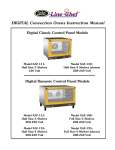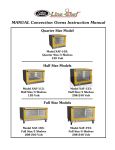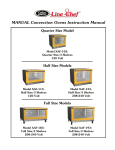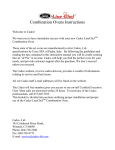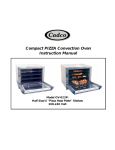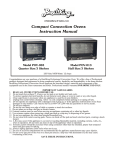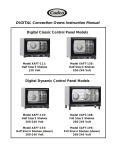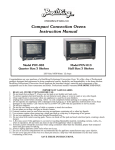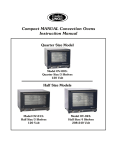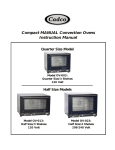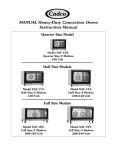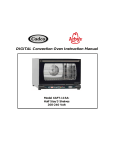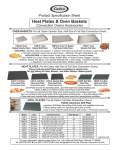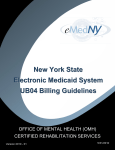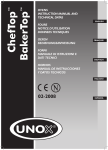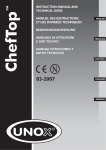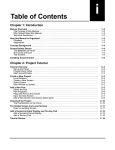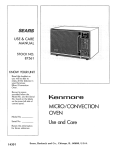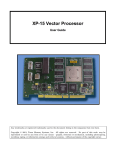Download Cadco XAF-115 User's Manual
Transcript
DIGITAL Convection Ovens Instruction Manual Digital Classic Control Panel Models Model XAF-111: Half Size/3 Shelves 120 Volt Model XAF-130: Half Size/4 Shelves (shown) 208-240 Volt Digital Dynamic Control Panel Models Model XAF-115: Half Size/3 Shelves 208-240 Volt Model XAF-188: Full Size/3 Shelves 208-240 Volt Model XAF-135: Half Size/4 Shelves 208-240 Volt Model XAF-195: Full Size/4 Shelves (shown) 208-240 Volt INDEX: I. Instructions For The Installer ............................................................................................................. 3 1. Data Plate ....................................................................................................................................... 3 2. Certification .................................................................................................................................... 3 3. Installation - Preliminary Operations .............................................................................................. 3 3.1 – Location of Installation ....................................................................................................... 3 3.2 – Feet Assembly..................................................................................................................... 3 3.3 – Positioning .......................................................................................................................... 3 3.4 – Removing Protective Film ................................................................................................. 3 4. Installation ...................................................................................................................................... 4 4.1 - Electrical Connection .......................................................................................................... 4 4.2 - Water Connection (for applicable models).......................................................................... 4 II. Instructions For The User .................................................................................................................. 4 1. Instruction For The Operator .......................................................................................................... 4 2. Notes For Use ................................................................................................................................. 4 3. Control Panel .................................................................................................................................. 5 3.1 – Use of “Classic” Control Panel .......................................................................................... 5 Manual Mode ...................................................................................................................... 5 Programmed Mode.............................................................................................................. 6 Automatic Preheat in Programmed Mode........................................................................... 6 3.2 - Use of “Dynamic” Control Panel ....................................................................................... 7 Manual Mode ...................................................................................................................... 7 Programmed Mode.............................................................................................................. 8 Automatic Preheat in Programmed Mode........................................................................... 8 Manual Water...................................................................................................................... 9 4. Door & Fans ................................................................................................................................... 9 5. Cleaning Oven .............................................................................................................................. 10 6. Turning Off In Case Of Breakdown ............................................................................................. 10 III. Cooking Principles .......................................................................................................................... 10 1. Cooking Modes ............................................................................................................................. 10 2. Cooking Variables ........................................................................................................................ 10 3. Use of Wire Grids & Sheet Pans .................................................................................................. 11 IV. Maintenance ..................................................................................................................................... 11 1. Ordinary Maintenance .................................................................................................................. 11 2. Special Maintenance ..................................................................................................................... 11 2.1 – Replacement of Internal Lamp ......................................................................................... 11 2.2 – Replacement of The Fuse ................................................................................................. 12 2.3 – Reset The Safety Thermostat ........................................................................................... 12 2.4 – Remove and Reattach the Oven Door............................................................................... 13 V. Optional Oven Accessories ................................................................................................................ 14 VI. Cooking Guide .................................................................................................................................. 15 VII. Warranty.......................................................................................................................................... 20 2 I. INSTRUCTION FOR THE INSTALLER Congratulations! You have just purchased a new Cadco LineChefTM Digital Convection Oven. Let’s go over some of the basics before you start using your new oven. 1. DATA PLATE 2. CERTIFICATION 2.1 The “CSA” mark on our data labels and on our user manual refers to the following listings: Certifications are listed under UNOX S.p.A., CSA file #202281, including XAF series oven models Class Number: 2831-03 DESCRIPTION: HEATERS-Cooking and Liquid - Stationary Type Class Number: 2831-83 DESCRIPTION: HEATERS-Cooking and Liquid-Stationary TypeCertified to U.S. Standards TO THE REQUIREMENTS OF UL 197 (8th edition) 2.2 The “NSF” mark refers to listing including XAF series oven models under UNOX SPA for NSF/ANSI STANDARD 4: Commercial Cooking, Rethermalization and Powered Hot Food Holding and Transport Equipment 3. INSTALLATION - PRELIMINARY OPERATIONS All electrical connections and installation operations must be done by qualified personnel, and comply with all existing codes. 3.1 CHECK THE LOCATION OF INSTALLATION Verify the overall measurements and the exact position of the electrical and water connections (where applicable) before installing the oven. Refer to the illustrations in the separate “technical data” document for your model. 3.2 FEET ASSEMBLY You will find the feet packed inside your oven’s cooking cavity. The feet must be used when your oven is in operation. Never use your oven without its feet properly installed. Assemble the feet as shown. (Full size models now come with tall feet that screw into place; all other models come with shorter feet that pop into place.) 3.3 POSITIONING Place your oven so the back and sides can be easily reached. This will make the electrical connections and any servicing points easily accessible. Your oven is not designed for built-in applications or for side by side positioning. Cadco suggests you leave a minimum distance of 4” between the back of the oven and the wall to allow for the escape of moisture. The oven must be placed upon a support, a stand, or on top of a counter made of non-combustible material. Never install the oven directly on the floor. If the oven is placed near walls, dividers, kitchen cabinets, decorated edges or drapes, they must be made of non combustible material. 3.4 REMOVE THE PROTECTIVE FILM Carefully remove all the protective film from the external walls of your oven. Be sure to remove any residual glue left on the outside of the oven with an appropriate solvent. 3 4. INSTALLATION 4.1 ELECTRICAL CONNECTION • Connection to the electrical power source must be done according to all state and local codes. Before connecting your oven, make sure that the voltage and the amps comply with those stated on the data plate of your oven. Avoid using patch cords and multiple jacks. • The appliance must be placed so that the connection plug to the outlet can be easily reached. When the appliance is in operation, the power supply voltage must not diverge from the value of the nominal voltage, written on the technical data plate, by more than + or – 10%. • Ovens are equipped with cordset and NEMA plug (single phase; 120V or 208-240V, depending on oven model.) It is sufficient to insert the plug in the proper outlet (the outlet must be suitable for the plug assembled on the oven.) 4.2 WATER CONNECTION (available on all digital models EXCEPT XAF-111 & XAF-130, per below) • CONNECTION TO THE WATER NET: Full Size digital oven models (XAF-188 & XAF-195) come with an electrovalve for direct water connection. ♦ A mechanical filter must be placed between the water system and the water connection of the oven. ♦ Before connecting the water pipe to the oven, please allow a suitable amount of water flow, in order to clean the duct from any residue. ♦ The water used in the oven must have a nominal pressure value between 0.5 and 2 bars. ♦ The water must have a hardness between 0.5° and 5°F (to avoid formation of lime deposits inside the electric valve and inside the cavity). ♦ Cadco suggests you use a decalcification filter in order to maintain fan balance. • AUXILIARY WATER PUMP: Half Size digital ovens with Dynamic control panels (XAF-115 & XAF-135) come with an EL080 Auxiliary Water Pump included, for manually pumping water from a bucket or other container. WARNING: Before using the water pump, always make sure that there is water in the tank. Damage to the pump can occur if it is operated without water in the tank and it will void your warranty. If the pump makes “groaning” sounds, it is probably due to lack of water in the tank or the pump is simply running an air bubble through the system. • Hot air and steam will exit the oven from the back exhaust port. During most cooking cycles, you will have hot and humid exhaust coming out from this exhaust port (temperature and humidity of this exhaust depend on the cooking parameters being used.) The steam that comes out of the exhaust port can also be vented outside if desired. II. INSTRUCTIONS FOR THE USER Never allow grease splatters or spills to collect on the inside walls, floor, or ceiling of your oven. A simple cleaning with soap and water is usually enough to keep your oven spotless and in “like new” condition for years. Your oven should never be cleaned with a water hose or anything more powerful than a spritz bottle. For tougher cleaning and built up grease, we suggest using Foam Plus® from Discovery Products Corporation (Tel. 877.822.8500.) 1. INSTRUCTIONS FOR THE OPERATOR You will find important information about maintaining and operating your new oven in this manual. Please read the manual and become familiar with your new oven before you begin to operate it. Keep the manual in a safe place and make sure everyone reads it before operating the oven. Please use only Cadco authorized service centers and always require quality UNOX-OEM parts. Failure to comply with these standards can compromise safety and will void your warranty. 2. NOTES FOR USE • Your Cadco oven was designed to cook food and must be used only for that specific purpose. Any other use may void your warranty. The usable operating temperature range is approx. 140°F to 500°F. It is suggested that you allow about 2-3” between trays for proper air circulation during the cooking process. 4 • Use your Cadco oven for: ♦ Baking all types of bread and pastry, both fresh and frozen. ♦ Cooking any meat, fish, or fowl. ♦ Rethermalizing any cooled or frozen cooked foods. ♦ Cooking (not steaming) any kinds of vegetables. Please avoid salting your food products while they are inside the cooking cavity. Salt is very corrosive and may, over time, damage the interior of your oven. 3. CONTROL PANEL OVEN MODEL XAF-111 XAF-115 XAF-130 XAF-135 XAF-188 XAF-195 CONTROL PANEL TYPE CLASSIC DYNAMIC CLASSIC DYNAMIC DYNAMIC DYNAMIC HUMIDITY CAPABLE NO YES NO YES YES YES CAPABLE OF RUNNING OPTIONAL PROOFER NO XAL135 NO XAL135 XAL195 XAL195 3.1 USE OF “CLASSIC” CONTROL PANEL (Models XAF-111 & XAF-130) The Classic Control Panel can operate in “Manual” and in “Programmed” modes. For each cooking cycle (both in the Manual and in the Programmed mode) the operator can set cooking time and oven temperature. MANUAL MODE • Switching On / Switching Off ♦ When the power is turned on, the light in the cooking cavity will come on and remain on while there is power to the oven. The display window will read “0.00” (this shows the time in hours and minutes). ♦ 15 minutes after a preset program ends or the cooking time expires, the light inside the cooking chamber will automatically shut off. The display and lights will be off, except for the red START / STOP light. To switch on the control panel, simply press the START / STOP key. • SELECT KEY The SELECT key allows the operator to select and set two functions: TIME and TEMPERATURE. • TIME ♦ To choose the Time function, press the SELECT key until the red Time indicator light is lit next to the Time icon (clock) on the control panel. ♦ To set the time function, use the or key. Hold the key down to quickly scroll to desired setting. ♦ The maximum time allowed in each step is 9 hours and 59 minutes, which will show in the display window as “9.59”. Minimum time per step is 1 minute. 5 ♦ Press the key when time is set at “0”, and “INF” will appear in the display window. The oven will then work continuously until you stop it by pressing the START / STOP key. • TEMPERATURE ♦ To choose the Temperature function, press the SELECT key until the red Temperature indicator light is lit next to the Temperature icon (thermometer) on the control panel. ♦ To set the temperature, use the or keys. Hold the key down to quickly scroll to desired setting. ♦ The usable operating temperature range is approx. 140°F to 500°F. The default temperature is 356°F. ♦ Always preheat oven cavity before placing food in the oven. • START / STOP COOKING CYCLE ♦ To start or stop the cooking cycle, press the START / STOP key. ♦ At the end of the cooking cycle, the heating element(s) and fan(s) will stop running and a tone will sound for 15 seconds. The digits “0.00” will flash for 45 seconds in the display window. The original temperature remains as entered at the beginning of the cooking cycle and the START / STOP LED will remain on. ♦ If during these 45 seconds, the operator chooses to set a different time/temperature (using the or , SELECT keys) and begin another cook cycle, the oven will then automatically begin the new and cook cycle. ♦ At the end of the 45 seconds, or if the cooking cycle is interrupted by pressing the START / STOP key, all the parameters previously set will be erased, unless they have been saved as a “program” and assigned a number in memory. (See “PROGRAMMED MODE” below.) • TO VIEW / MODIFY YOUR COOKING PARAMETERS DURING THE COOKING CYCLE While the oven is in its cooking cycle, it is possible to view the cooking parameters and modify them if the oven is operating in the manual mode. To view the different parameters (Time, Temperature), simply press the SELECT key to advance the light. ♦ If you select “Time”, the display shows the remaining time. ♦ If you select “Temperature”, the display will alternate between the set temperature (steady light) and the actual temperature (flashing light). PROGRAMMED MODE • There is room to save up to 70 programs in your oven’s memory for “One Touch Cooking”. • TO ENTER A PROGRAM INTO MEMORY: 1. Press the P key. The display will read “P01”. 2. Select the number of the program you wish to use by pressing the or buttons (the program number will show in the display window) 3. Press the SELECT key. 4. Set the cooking parameters (Time and Temperature) (See MANUAL MODE section above.) 5. Save the program by pressing the Memory key (for about 5 seconds) until you hear a tone. When the tone is heard, the program is saved, and the program number will appear in the display window. 6. You may press the P key to go back into the manual mode at any time. 7. To start the program, press the START / STOP key. • 6 TO RECALL A PROGRAM ALREADY IN MEMORY: 1. Press the P key. The display will read “P01”. 2. Select the number of the program you wish to use by pressing the will show in the display window) 3. To start the program, press the START / STOP key. or key (the program number • AUTOMATIC PRE-HEATING ♦ When you activate a memorized program with the START/STOP key, the oven will automatically preheat the cooking cavity and you will see no numbers in the display window, just the letters “PRE.” ♦ Pre-heating temperature is equal to the set temperature plus approximately 20%. ♦ When the oven reaches the pre-heating temperature, it gives a long tone. At this point, open the door, place the food inside the oven and close the door; your chosen program will begin cooking automatically. • TO VIEW YOUR COOKING PARAMETERS DURING THE COOKING CYCLE: While the oven is in its programmed cooking cycle, it is possible to view the cooking parameters. To view the different parameters (Time, Temperature), simply press the SELECT key to advance the light. ♦ If you select “Time”, the display shows the remaining time. ♦ If you select “Temperature”, the display will alternate between the set temperature (steady light) and the actual temperature (flashing light). ♦ When the oven is in its programmed cooking cycle, you may modify the Time parameter (add minutes) while the program is in progress. • START / STOP COOKING CYCLE ♦ To start or stop the cooking cycle, press the START / STOP key. ♦ At the end of the cooking cycle, the heating element(s) and fan(s) will stop running and a tone will sound for 15 seconds. The digits “0.00” will flash for 45 seconds in the display window. The original temperature remains as entered at the beginning of the cooking cycle and the START / STOP LED will remain on. ♦ If during the 45 seconds of flashing digits the operator chooses to set a different time/temperature SELECT keys) and begin another cook cycle, the oven will then (using the or , and automatically begin the new cook cycle. ♦ At the end of the 45 seconds, or if the cooking cycle is interrupted by pressing the START / STOP key, all the parameters previously set will be set to 0 and the START/STOP LED will be switched off. 3.2 USE OF THE “DYNAMIC” CONTROL PANEL (Models XAF-115, XAF-135, XAF-188, XAF-195) The Dynamic control panel can work both in Manual and in Programmed modes. For each cooking cycle (both in the Manual and in the Programmed mode) the operator can set 3 cooking steps. For each step, you enter cooking time, oven temperature, and humidity %. MANUAL MODE • Switching On / Switching Off ♦ When the power is turned on, the light in the cooking cavity will come on and remain on while there is power to the oven. The display window will read “0.00” (this shows the time in hours and minutes). ♦ 15 minutes after the end of the cooking cycle (in both the Manual and the Programmed mode), or 7 when the operator pushes the START / STOP key, if no other keys are pressed, the control panel automatically switches off. The display, control panel lights, and light inside the cooking chamber will all be off, except for the red START / STOP light. To switch on the control panel, simply press the START/STOP key again. • SELECT KEY The SELECT key allows the operator to select any of the three cooking parameters: TIME, TEMPERATURE, and HUMIDITY. • TIME ♦ To choose the Time function, press the SELECT key until the red Time indicator light is lit next to the Time icon (clock) on the control panel. ♦ To set the time function, use the or key. Hold the key down to quickly scroll to desired setting. ♦ The maximum time allowed in each step is 9 hours and 59 minutes, which will show in the display window as “9.59”. Minimum time per step is 1 minute. ♦ Press the key when time is set at “0”, and “INF” will appear in the display window. The oven will then work continuously until you stop it by pressing the START / STOP key. • TEMPERATURE ♦ To choose the Temperature function, press the SELECT key until the red Temperature indicator light is lit next to the Temperature icon (thermometer) on the control panel. ♦ To set the temperature, use the or keys. Hold the key down to quickly scroll to desired setting. ♦ The usable operating temperature range is approx. 140°F to 500°F. The default temperature is 356°F. • HUMIDITY ♦ To choose the Humidity function, press the SELECT key until the red Humidity indicator light is lit next to the Humidity icon (water drops) on the control panel. ♦ To set the percentage of humidity, press the or keys. Humidity can be set from low of 0 to high of 100, in increments of 20. These ovens are not designed for steaming foods. ♦ When operating below 300°F, a maximum humidity setting of 40 or less is recommended. Otherwise, the oven may develop excess water in the cooking cavity. • STEP KEY The STEP key allows the operator to select one, two, or three cooking steps. These steps will run in sequence when cooking values (Time, Temperature, and Humidity) have been entered in each step, and may be saved as a program if desired. (See “PROGRAMMED MODE” below.) • START / STOP COOKING CYCLE ♦ To start or stop the cooking cycle, press the START / STOP key. ♦ At the end of the cooking cycle, the heating element(s) and fan(s) will stop running and a tone will sound for 15 seconds. The digits “0.00” will flash for 45 seconds in the display window. The original temperature remains as entered at the beginning of the cooking cycle and the START / STOP LED will remain on. ♦ If during the 45 seconds of flashing digits, the operator chooses to set a different time / temperature / humidity variable (using the or , and SELECT keys) and begin another cook cycle, the oven will then automatically begin the new cook cycle. ♦ At the end of the 45 seconds, or if the cooking cycle is interrupted by pressing the START / STOP key, all the parameters previously set will be erased, unless they have been saved as a “program” and assigned a number in memory. (See “PROGRAMMED MODE” below.) • TO MODIFY YOUR COOKING PARAMETERS DURING THE COOKING CYCLE While the oven is in its cooking cycle, it is possible to review the cooking parameters and modify them if 8 the oven is operating in the manual mode. To view the different parameters, simply press the SELECT key to advance the light to the icon/operation you wish to review (Time, Temperature, Humidity). ♦ If you select “Time”, the display shows the remaining time for that step. ♦ If you select “Temperature”, the display will alternate between the set temperature (steady light) and the actual temperature (flashing light). ♦ If you select “Humidity”, the display will show the percentage of humidity you originally selected for that step. PROGRAMMED MODE • There is room to save up to 70 programs in your oven’s memory for “One Touch Cooking”. Each program can have a maximum of 3 cooking steps. • TO ENTER A PROGRAM INTO MEMORY: 1. Press the P key. The display will read “P01”. 2. Select the number of the program you wish to use by pressing the or buttons (the program number will show in the display window) 3. Press the SELECT key. 4. Set the cooking parameters (Time, Temperature, Humidity if applicable) (See MANUAL MODE section above.) 5. Save the program by pressing the Memory key (for about 5 seconds) until you hear a tone. When the tone is heard, the program is saved, and the program number will appear in the display window. 6. You may press the P key to go back into the manual mode at any time. 7. To start the program, press the START/STOP key. • TO RECALL A PROGRAM ALREADY IN MEMORY: 1. Press the P key. The display will read “P01”. 2. Select the number of the program you wish to use by pressing the will show in the display window) 3. To start the program, press the START / STOP key. or key (the program number • AUTOMATIC PRE-HEATING ♦ When you activate a memorized program with the START/STOP key, the oven will automatically preheat the cooking cavity and you will see no numbers in the display window, just the letters “PRE.” ♦ Pre-heating temperature is equal to the set temperature plus approximately 20%. ♦ When the oven reaches the pre-heating temperature, it gives a long tone. At this point, open the door, place the food inside the oven and close the door; your chosen program will begin cooking automatically. • TO VIEW YOUR COOKING PARAMETERS DURING THE COOKING CYCLE: While the oven is in its programmed cooking cycle, it is possible to view the cooking parameters. To view the different parameters (Time, Temperature), simply press the SELECT key to advance the light. ♦ If you select “Time”, the display shows the remaining time. ♦ If you select “Temperature”, the display will alternate between the set temperature (steady light) and the actual temperature (flashing light). ♦ • When using a program, you will be unable to modify the cooking parameters during the cooking cycle. START / STOP COOKING CYCLE ♦ To start or stop the cooking cycle, press the START / STOP key. ♦ At the end of the cooking cycle, the heating element(s) and fan(s) will stop running and a tone will sound for 15 seconds. The digits “0.00” will flash for 45 seconds in the display window. The original temperature remains as entered at the beginning of the cooking cycle and the START / STOP LED will remain on. ♦ If during the 45 seconds of flashing digits the operator chooses to set a different time/temperature (using the or , and SELECT keys) and begin another cook cycle, the oven will then 9 ♦ automatically begin the new cook cycle. At the end of the 45 seconds, or if the cooking cycle is interrupted by pressing the START / STOP key, all the parameters previously set will be set to 0 and the START/STOP LED will be switched off. MANUAL WATER • While the oven is working (both in the Manual or in the Programmed mode) it is possible to add a spritz of water inside the cavity by pressing the “MANUAL WATER” key. • The electric water valve works only when the key is pressed, and if water has been hooked up to the oven (see 4.2 WATER CONNECTION on page 4). 4. DOOR & FANS • Oven Door Safety TM ♦ On each LineChef Digital Convection Oven, there is a switch that stops the cook cycle when you open the door. ♦ When you open the door, the cooking cycle (in both the manual and the programmed mode) goes into pause mode, though no cooking values are lost. ♦ When you close the door, the cooking cycle restarts from where it was interrupted. • Convection Fans Every 2 minutes, the fan(s) stop and reverse direction to assure even baking. 5. CLEANING THE OVEN • WARNING: Before starting any maintenance or cleaning operation, it is necessary to disconnect the electrical power supply and wait for your oven to cool down. 5.1 BEFORE USING THE OVEN ♦ Clean the metal parts with hot soapy water and rinse thoroughly. ♦ With the cooking cavity empty, heat the oven for about 30 minutes at a temperature of 350°F to “burn it in”. ♦ Never wash the cooking chamber with acids, abrasives, or aggressive detergents. 5.2 CLEANING THE COOKING CAVITY ♦ Make sure to wipe up any and all spills as they occur. ♦ At the end of the day (or as needed), clean the cavity using only proper products. ♦ Never clean the stainless steel with acids, caustic detergents, abrasives or any products containing chlorine. 5.3 CLEANING THE OUTSIDE OF YOUR OVEN ♦ Wipe up spills, as they occur, with a damp cloth. ♦ Never use a spray of water in to clean the outside of your oven. This may damage the electrical components and void your warranty. 6. TURNING OFF IN CASE OF BREAKDOWN If you encounter any kind of problem while your oven is in operation, or if you notice anything out of the ordinary, follow these steps: ♦ Unplug your oven immediately. ♦ Consult Cadco, Ltd. at 877-603-7393 (Toll-Free) Failure to do so may result in a hazardous condition and void your warranty. III. COOKING PRINCIPLES 1. COOKING MODES • CONVECTION COOKING ♦ Food products bake in hot, moving air. This moving air removes the cool air barrier between the cool food being cooked, and the heat of the oven chamber. It also helps your food products to cook evenly 10 and quickly. Foods cook faster with convection. • CONVECTION & HUMIDITY (Humidity models) ♦ Adding measured amounts of humidity while baking helps many products retain moisture. In some cases, such as with Pate Choux, the product will gain in volume. ♦ Moisture also makes the heat seem hotter (similar to a humid day) and products may cook a little faster. 2. COOKING VARIABLES • TEMPERATURE ♦ The exact setting of your oven temperature assures proper cooking of your food, both inside and outside: Too low – your food cooks too slowly and will dry out. Too High – your foods burns and cooks unevenly. TM ♦ If you are new to convection cooking, Cadco suggests setting your LineChef Convection Oven to a temperature of about 30ºF - 50ºF lower than what you would have set it at in a conventional oven. Let the food tell you what it needs; if it browns too fast, turn the oven temperature down. • TIME ♦ The higher the temperature the quicker your foods will get done. ♦ The quicker foods (especially protein products) cook, the more moisture they tend to lose. ♦ Most bakery products can take high temperatures better than protein products. • HUMIDITY The more humidity in the cooking cavity, the harder it will be for your food products to brown. • QUANTITY OF FOOD ♦ One piece of chicken will take less time to cook than 2 or 3 pans of chicken. That’s “Mother Nature” pure and simple. Convection cooking is fantastic, but it’s NOT magic. ♦ Overloading the oven can result in uneven cooking. ♦ Avoid placing baked goods touching each other on the pan before baking. 3. USE OF WIRE GRIDS AND SHEET PANS • It is recommended to use wire grids for meat items. This will elevate your food items and allow air to circulate all around during the cooking process. Place your wire rack in a sheet pan to collect the juice. This reduces clean-up time also. • Use sheet pans for bakery items such as pastries, bread and rolls, and cookies. IV. MAINTENANCE 1. ORDINARY MAINTENANCE • All maintenance operations must be done only by trained qualified personnel. • Before starting any maintenance operation, disconnect your oven from the electrical power supply and wait for it to cool down. • The parts that need ordinary maintenance can be reached by removing the front control panel and the back of the oven. 2. SPECIAL MAINTENANCE • All maintenance operations must be done only by trained qualified personnel. • Before starting any maintenance operation, disconnect your oven from the electrical power supply and wait for it to cool down. 2.1 REPLACEMENT OF INTERNAL LAMP To replace the internal lamp: • Disconnect your oven from the power supply system and let it cool down. • Remove the side rails. • Unscrew the glass cover and replace the lamp with an identical bulb. 11 • • Screw the glass cover back on. Reassemble the side rails. 2.2 REPLACEMENT OF THE FUSE To replace the fuse: • Press on the cover of the fuse holder and rotate it of about 20° counterclockwise. • Remove the cover of the fuse holder. • Remove the fuse from the cover of the fuse holder. • Replace the fuse with one with an identical one. • Reposition the cover of the fuse holder. • Press the cover and rotate it about 20° clockwise. 2.3 RESET THE SAFETY THERMOSTAT • This oven is equipped with a manually resettable safety thermostat designed to protect the oven against overheating. If there is an intervention, it completely deactivates the oven to avoid permanent damage. • To reset this device, remove the black cap positioned to the bottom of the back of the oven by unscrewing it counterclockwise, push the reset button under the cap, and replace the black cap. • If the safety thermostat shuts your oven off, before turning your oven back on, be sure to check your entire circuit to verify that the total amps being drawn by all the appliances, lights, etc. on that circuit do not exceed the amps available on that circuit. NOTES _______________________________________________________________________________________ _______________________________________________________________________________________ _______________________________________________________________________________________ _______________________________________________________________________________________ _______________________________________________________________________________________ _______________________________________________________________________________________ _______________________________________________________________________________________ _______________________________________________________________________________________ _______________________________________________________________________________________ _______________________________________________________________________________________ _______________________________________________________________________________________ _______________________________________________________________________________________ _______________________________________________________________________________________ _______________________________________________________________________________________ _______________________________________________________________________________________ _______________________________________________________________________________________ _______________________________________________________________________________________ 12 2.4 REMOVE AND REATTACH THE DOOR Open door completely as in Fig. 1 Fig. 1 Fig. 2 Using a screw driver or other object, swing door safety lock down as shown in Figs 2 – 3 – 4 Fig. 4 Fig. 3 With door completely down and door safety lock in its down position, move door in a closing direction until door safety lock stops the closing action as in Fig. 5. ~~~~~~~~ Hold door as shown in Fig. 6. Fig. 6 Fig. 5 Slightly lift and swing door out of unit as shown in Figs. 7 & 8 Fig. 7 Fig. 8 For the door to be properly installed, the notch on the bottom of the hinge finger (Fig. 9) must be seated in the inner door hinge frame (Fig. 10) Fig. 10 Fig. 9 Reverse above procedure to attach door to oven - see Figs. 7 & 8 13 V. OPTIONAL DIGITAL CONVECTION OVENS ACCESSORIES • XAL195 Full Size Proofer TM ♦ Must be used with a full size LineChef Digital Oven with Dynamic control panel (oven models: XAF-188 and XAF-195) TM ♦ Oven and proofer are both set using the LineChef Digital Oven Dynamic control panel. ♦ The proofer must be on a separate power source from the oven. ♦ Capacity of 8 full sized (18”x 26”) sheet pans. • XAL135 Half Size Proofer TM ♦ Must be used with a half size LineChef Digital Oven with Dynamic control panel (oven models: XAF-115 and XAF-135). TM ♦ Oven and proofer are both set using the LineChef Digital Oven Dynamic control panel. ♦ The proofer must be on a separate power source from the oven. ♦ Capacity of 8 half sized (13”x 18”) sheet pans. • • XR190 Oven Stand (full size) (Note: Shorter oven feet must be used when placing oven on this stand.) ♦ Accommodates oven models: XAF-183, XAF-188, XAF-193 & XAF-195 XR130 Oven Stand (half size) ♦ Accommodates oven models: XAF-111, XAF-113, XAF-115, XAF-133, XAF-115, XAF-130, & XAF-135 • XR621 Wheels Kit for Oven Stands (for all XR series stands) ♦ 2 front wheels with brakes ♦ 2 wheels without brakes • GRF018 Oven Fry Basket (Full Size) ♦ 2 ½ pound (approx.) capacity • GRP825 Poultry Rack (Full Size) ♦ Holds a maximum of eight 3 pound birds FAKIROTM Heat Plates provide very fast baking times, up to 50% faster than traditional baking pans. It takes as little as 4-5 minutes to bake a fresh Pizza on the FAKIROTM plate! The plates are manufactured from alloys which provide superior heat storage and produce fast, even cooking of both top and bottom of the food product simultaneously. FAKIROTM plates are designed with burls on the lower surface of the plate, which intensify the heating action • ♦ ♦ 14 TG450 FAKIRO™ Heat Plate (Full Size) For very fast baking times of pizzas, breads, etc. TG320 FAKIRO™ Heat Plate (Half Size) For very fast baking times of pizzas, breads, etc. VI. COOKING GUIDE The first and most important step will be: Have your new oven hooked up to the proper power and (if applicable) water source. If there is any doubt about the proper power or the connections, have the oven installed by a qualified electrician according to your local codes. Use this cooking guide to help determine which time and temperature works best for your specific food items. If your specific product isn’t addressed, you will probably find something similar. You’ll find many helpful hints in this cooking guide. Our aim is to help you use your Cadco LineChefTM Digital Convection Oven to its fullest, rather than teach you how to cook. The Cadco LineChefTM Digital Convection Ovens work on the principle of moving air. This air movement removes the “Hot Spots” so we get very even browning, rapid preheats (10 minutes), and faster cooking. Here are some basic do’s and don’ts and guidelines for convection cooking: ♦ Use pans that have sides no taller than a common sheet pan. ♦ Preheat the oven to approximately 20% above your baking temperature. After loading your product, remember to reset the oven to the desired baking temperature. ♦ Set the oven for your desired cooking temperature after you have placed the food inside. ♦ If you notice uneven cooking, set the oven temperature down 25º-30ºF. Let the product tell you if it needs more or less heat. ♦ Aluminum foil can get pulled into the fan and cause damage. ♦ Don’t overload the oven. ♦ Maintain a minimum 2”-3” between the product being cooked and the next shelf. Remove shelves if necessary. ♦ Your Cadco Convection Oven is a powerful tool, so don’t hesitate to utilize its full capacity. Keep your oven clean. Wipe up spills as they occur. Never allow grease to build up on the interior of the oven, or collect on the bottom of the cooking cavity. Frozen products draw more heat from the oven and may require a longer recovery time. When roasting meats we suggest using a cooking rack to elevate the product and facilitate even roasting. Smaller cuts such as boneless chicken breasts, or seafood portions may be baked directly on the pan if desired. Lower temperatures will reduce shrinkage and save money with all of your roasted meat products. Higher geographical elevations will often affect cooking time and temperature parameters. ♦ ♦ ♦ ♦ ♦ Have fun and experiment with your new Cadco Convection Oven. Your times and temperatures will vary with the different products you prepare. Refer to this Cadco Cooking Guide for direction or contact the Cadco Certified Executive Chef (877.603.7393) or the Cadco, Ltd. website (www.cadco-ltd.com), for specific answers to your cooking needs. ***A FREE Video Demonstration DVD is available from Cadco to familiarize your employees with these ovens. We look forward to hearing from you, Loren Lippitt C.E.C. Cadco, Ltd. Certified Executive Chef 15 Cookies Baking Temperature One of the most common items baked in your Cadco Convection Oven will be cookies. There are dozens of cookie manufacturers, and their products all have different baking characteristics. Most of the cookie recipes suggest a baking temperature of 325º - 350ºF. I have found that “Lower is better”. Over the years we have found that cookies bake best in a preheated oven at about 285º - 300ºF, assuming a 1.5 ounce cookie from refrigerated/frozen dough. By baking at a lower temperature, they tend to remain higher after cooling and produce a more eye appealing finished product. Bake for about 12-18 minutes, depending on what you think is the perfect cookie. Variables ♦ Lower the temperature for larger cookies. ♦ Cookies bake from the outside in...so to make picture perfect cookies we have to consider two variables before we begin baking, in any oven, or we may not be happy with our results. These two factors come into play mostly when we make cookies from "scratch", (but they apply to all cookies): 1. The temperature of the dough Room temperature dough will spread out more than frozen or refrigerated dough. The colder the dough, the less the cookie will spread / flatten out during baking. Dough baked from frozen produces a thicker, better-looking cookie than ones that are baked from refrigerated, or room temperature, which will spread out and therefore, have less height. 2. The fat content of the dough. A higher ratio of fat to flour will make the cookie spread out more during baking. • Cheesecake People generally love cheesecake and it’s not hard to make. Let’s start with a basic cheesecake batter: ♦ #3 cream cheese ♦ 1 ½ cups sugar ♦ 5 eggs ♦ lemon to taste ♦ 2 cups Half and Half (approx.) This will make enough batter for a 10” springform pan. There are so many fun options for making cheesecake, such as: ♦ Substitute chocolate milk for Half and Half in a triple chocolate cheesecake. ♦ Orange juice for an orange cheesecake. ♦ Baileys Irish Cream. ♦ Cookie dough. ♦ Turtle cheesecake. ♦ Lemon poppy seed. ♦ Pumpkin…peanut butter…pistachio…what else? For my crust, I usually spray the inside of the springform pan with vegetable oil and dust it with graham cracker crumbs. There are endless options for crusts such as shortbread, brownie, or Ladyfingers, or my simple dusting of graham crumbs. It’s your choice. Bake in a 200ºF oven for 4 hours, then cool, cut and serve. Have fun with some imaginative sauces also: ♦ Walnut, caramel and chocolate chip sauce. ♦ Lemon sauce. ♦ Pear sauce ♦ Pistachio sauce. ♦ Cinnamon Squared² Sauce (cinnamon stick and candies). 16 • Muffins ♦ 15 minutes at 325ºF/ 20% humidity works well for most standard size muffins. ♦ For jumbo muffins set the oven temp at 300ºF/ 20% humidity and bake the muffins for 20 minutes or until a toothpick comes out clean. ♦ The more dense your batter is the longer your muffins will take to bake. • Biscuits For the test we used a basic baking powder biscuit about 3” in diameter. Bake at 350ºF for 10-12 minutes. Some suggestions: ♦ A simple glaze can be made of powdered sugar and water. ♦ Glaze while your biscuits are still hot. ♦ Try peanut butter, lemon poppy seed, cinnamon raisin, cheese and bacon, sour dough, and of course, good old buttermilk biscuits. ♦ Drop biscuits take about the same amount of time to bake and they are wonderful. Call me and I’ll share a family favorite with you. Biscuits can be so much fun to make and they are so easy that even kids can help make them. I remember Mom throwing biscuits together for breakfast when we were growing up. Hot, delicious and full of TLC, it just took her a few minutes, and I even got to help! • Bread ♦ Large loaves (1 lb -1 ½ lb) baked in 30 - 40 minutes at 325ºF. ♦ We found that you can bake dinner rolls using the same method as you do for biscuits. ♦ Call and ask about “Butterflake Dinner Rolls” You’ll love them! (While you have me on the phone ask about sourdough starter. You’ll be amazed at how simple it is to make and to use.) • Pies The variables for bakery products are endless, and pies are no exception. These are some of the things which will affect your cooking time: ♦ Amount of sugar in the crust. ♦ Size of your pie tin and the amount of filling used. ♦ Butter or oil in the crust. ♦ Amount of shortening to flour. ♦ Your choice of canned or fresh filling. For test pies we used 9” pie tins with homemade apple filling. Our crust was made using a basic 3-2-1 recipe: ♦ 3 parts flour ♦ 2 parts shortening ♦ 1 part (approx.) water ♦ With a little salt and a four finger pinch of sugar added The Cadco LineChefTM Convection Oven was preheated to 325ºF and the pies were baked for 45 minutes to an hour depending on the filling. The aroma coming out of the Cadco Training Center was fantastic! • Pizza There are so many pizzas it’s hard to know where to start. The pizza we used for our tests were the 11”, frozen, self rising type from the grocery store. They were all baked at 350ºF for 8 - 20 minutes on FAKIROTM Heat Plates (see page 12), and our results were great on all of them. (The pizza manufacturers suggested a temperature of 400ºF for 20-30 minutes). 17 • “Oven Fried” Chicken Let’s say that you want to serve fried chicken in your food service operation but you don't want all of the problems associated with a chicken program. You don't want to deal with an expensive breading program, the high insurance costs, constantly buying oil, employee training, the dangerous cleaning/filtering of French fryers, and the high cost of purchasing equipment. Cadco has the answer: how about "Oven Fried" chicken. We take cooked, frozen, browned chicken and season it with the seasoning(s) of your choice to produce the most delicious, unique chicken your customers have ever tasted...and it's all done in your oven in about 30 minutes. Your chicken goes from the freezer, to the oven, to the display case (and your customers) in less time than it takes to fry from raw. We suggest Pierce Super Chicken; lay it out in a Cadco Oven Fry Basket (Model GRF018/Full Size), and season the pieces with any seasoning of your choice. Then you simply bake it in the Cadco LineChefTM Convection Oven at 325ºF for 20 minutes and it's ready to serve. You can have Cajun, Lemon Pepper, Italian, TexMex, Smoky, Jamaican, or…Whatever flavor you want, “Oven Fried” Chicken! • “Rotisserie Style” Chicken Tired of paying the grocery store to make those delicious rotisserie chickens for you? Once you make your own “Rotisserie” chickens, in your Cadco Convection Oven, you’ll never buy another cooked chicken from the store again (and I’ll bet your customers won’t either). ♦ You’ll need a baking sheet pan and a cooking rack to keep your chicken elevated during the cooking process. The cooking rack allows air to circulate all around the chicken, similar to a rotisserie. Cadco offers a Model GRP825 Poultry Rack (for Full Size ovens only) which holds a maximum of eight 3 pound birds ♦ You can also place your chicken directly on the oven rack and let it drip into a pan below. ♦ Caution! Never allow grease to drip onto the bottom of the oven! Method ♦ Season a #3 chicken and place it on the cooking rack. (For options, see below) TM ♦ Preheat your LineChef Convection Oven to 325ºF. ♦ Roast the chicken for about 45 minutes. If a crispier product is desired, raise the temperature to about 350ºF. ♦ Cook chicken to an internal temperature of 180ºF. ♦ Stuffing the chicken will increase cooking time and it is NOT suggested. Options ♦ Slip slices of lemon under the skin on the breast before roasting. ♦ Italian sausage under the skin of the breast before roasting. ♦ Sun dried tomatoes, fresh herbs, under the skin before roasting. ♦ Spray the chicken with olive oil, season, and dust with mashed potato flakes before roasting. ♦ Save the chicken fat after roasting and chill it. Mix the fat, and a little stock, with left over shredded chicken, and season with salt and pepper, to make a spread on slices of French bread. Needless to say…this is NOT heart-healthy fare, but it sure is good. ♦ Truss the chicken before roasting for more even cooking and eye appeal. Call for my quick method of trussing a bird. • 18 Burgers ♦ Lay your ¼ pound frozen burgers out onto a sheet pan and season to taste. Place them into 350ºF oven for about 10 to 12 minutes. ♦ Hamburger should be cooked to an internal temperature of 165ºF to be safe according to HACCP guidelines. ♦ Try cooking your burgers at 250ºF for 15 to 20 minutes and notice how juicy they are. Browning is not as pronounced using the low temperature method, but the added flavor makes up for it. • Rare Roast Beef ♦ Rare beef is considered by most people to be 130ºF. ♦ The USDA states that full muscle beef when roasted to an internal temperature of 130ºF and maintained at that temperature for 121 minutes is considered safe to eat. ♦ Overnight roasting requires a roast that is 7 pounds or larger. ♦ Seasonings will penetrate the roast about 1/4” deep. ♦ We will give two examples of roast beef (Prime Rib and Roast Tenderloin): Both roasts will be cooked elevated on a roasting rack so we have air circulation all around during the roasting process. Both roasts will be cooked over a shallow sided pan to collect the pan juices for jus or gravy. Prime Rib (roast and hold method) Hold your beef roast for at least 8 hours, and keep the internal roast temperature from going higher than 130ºF. ♦ Each hour of holding (between 100ºF and 140ºF) is equal to one day of ageing. ♦ Roast your 8 pound Prime Rib at 225ºF until your internal probe reads 100ºF. ♦ Set the oven for “Infinite/Continuous” time and 140ºF temperature. (You will notice that the lowest temperature on the dial is 175ºF on manual oven models, so you will have to “best guess” where 140ºF is.) ♦ Roast Tenderloin (quick roast and serve method) – Preheat your oven to 400ºF ♦ Load the tenderloin in the oven and reduce the roasting temperature to 350ºF ♦ Roast the tenderloin to an internal temperature of 120ºF and remove from the oven. The roast will continue to rise in temperature. ♦ In about 10 minutes (130ºF) the tenderloin will be ready to slice and serve ♦ • Jus Use your pan drippings to make jus. Many people say “I’m going to make some au jus”. This is incorrect and professionals will notice. Au jus means “with juice”. Prime Rib becomes “Prime Rib Au Jus” when you add jus to the plated Prime Rib. ♦ Use beef/veal/chicken stock to dissolve all that wonderful tasting brown gooey material in the bottom of your roasting pan. Some add a little red wine, some add tomato, and some make their jus to theme: Cajun, Southwest, Oriental…..you get the idea. ♦ 19 VII. WARRANTY • Cadco, Ltd. warrants all products (in the United States and Canada) to be free from defects in material and workmanship for a period of one year from date of purchase, unless otherwise noted below. • Warranty does not apply in cases of misuse, abuse or damage from external service or repair attempts by unauthorized personnel. • Copy of original invoice is required for proof of purchase date for warranty coverage. • WARRANTY PERIODS: • ♦ ALL OVENS: 90 day warranty on all light bulbs and gaskets. NOTE: These items are easily changeable on-site by user and do not qualify for service center warranty assistance. Call Cadco directly for warranty replacement of these items. ♦ LineChefTM DIGITAL CONVECTION OVENS: (XAF-111, XAF-115, XAF-130, XAF-135, XAF-188, XAF-195) Two Year on-site warranty program WARRANTY PROCEDURES: ♦ Please do not take your unit to the store where you purchased it for warranty repair. For the Cadco authorized US service agent nearest you, please contact: Cadco, Ltd., 145 Colebrook River Road, Winsted, CT 06098 Tel. (860) 738-2500, Fax (860) 738-9772 E-mail: [email protected], Web site: www.cadco-ltd.com 6/13/2008 RV06 20




















